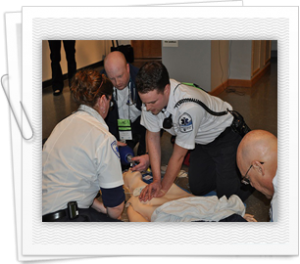Online CPR Certification Blog
Success of bystander CPR is improved when people help
Date: April 19th, 2014
 There is a very high chance that people who suffers from cardiac arrest outside hospital settings will make it if more than one bystander helps them. This statement is true according to researchers who also noted that the quality of bystander CPR is bound to improve if multiple people choose to assist the victim.
There is a very high chance that people who suffers from cardiac arrest outside hospital settings will make it if more than one bystander helps them. This statement is true according to researchers who also noted that the quality of bystander CPR is bound to improve if multiple people choose to assist the victim.
The quality of bystander CPR being administered outside any hospital setting was mostly reliant on the number of rescuers who attempted to offer a helping hand. In an urban or central setting the CPR was (OR 2.8, 95% CI 1.5-5.6) and the receipt of CPR initiated by bystanders was (OR 2.7, 95% CI 1.1-7.3). The length of resuscitation duration was longer and stood at (OR 1.1, 95% CI 1.0-1.1). The study was done and submitted by Hideo Inaba, MD, of the Kanazawa University Graduate School of Medicine in Japan.
It was noted that the quality of bystander CPR administered by family members wasn’t that impressive and stood at (P=0.0001). Bystander CPR performed by older people stood at (P=0.0005) while it was at (P<0.0001) in home environments.
Those who received good quality bystander CPR weren’t likely to suffer from any neurological damages. Their statistic was (2.7% vs 0%, P=0.14) against those who unfortunately suffered from brain damage due to lack of response or poor bystander CPR administration.
Making it count
A lot of the experts have noted that quality bystander CPR is important if patients are to either survive or avoid suffering from brain damage. There therefore need to be an aggressive implementation of bystander CPR to help patients who suffer from cardiac arrest while outside hospital settings. This will without a doubt positively impact survival rates and neurological outcomes. It was noted that the CPR could consist of hands only procedure and not mouth to mouth resuscitation.
The quality of bystander CPR was measure on factors such as
• Depth of compression which should be at least 2 inch or 1/3 of the anterior-posterior span of the chest
• Rate of compression administered by the bystander. It should be at least 100 per minute
• Positioning of the bystanders hand for adults and fingers when handling infants
Favorable factors determining neurological outcomes
The information that was gathered by the researchers included location of arrest, age, sex, region, witnesses present during the attack, etiology of the arrest and whether there was any form of CPR administered by bystanders. Another information included level of bystander experience and training in administering CPR, time take to dispatch emergency services, estimated time of collapse and instructions given to bystanders by paramedics among others. All these factors contributed in either increasing or decreasing the rate of survival. It also had a very significant impact in determining the neurological outcome of the patient or victim who suffered from sudden cardiac arrest while outside a hospital setting.
The study was believed to be limited in that they based their measurement of CPR quality administered after the arrival of EMTs and not in between the time the paramedics were dispatched and arrived at the scene.
